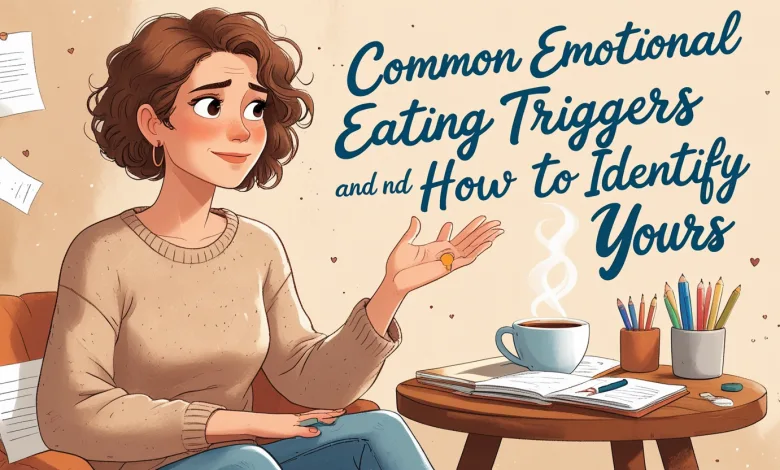Common Emotional Eating Triggers and How to Identify Yours

Ever found yourself reaching for that comfort food after a tough day? You’re not alone. Emotional eating affects millions, but identifying your specific triggers is the first step toward a healthier relationship with food. Let’s explore what might be behind those cravings and how to regain control.
Listen, we’ve all been there — standing in front of the fridge at midnight, spoon in hand, digging into that pint of ice cream after a stressful day. It’s not about hunger, it’s about feeling. Emotional eating is incredibly common, yet many of us don’t fully understand what triggers these episodes or how deeply they’re woven into our daily lives.
In this guide, we’ll dive into the world of common emotional eating triggers and, more importantly, help you identify which ones are affecting your relationship with food. Because hey, awareness is half the battle! Once you know what’s pushing your buttons, you can start developing healthier coping mechanisms that don’t involve a date with a chocolate cake at 2 AM.
What Exactly Is Emotional Eating?
Emotional eating happens when we use food to cope with feelings rather than to satisfy physical hunger. It’s turning to that bag of chips when you’re bored or demolishing a box of cookies after an argument. Sound familiar?
The thing is, emotional eating isn’t just about the occasional comfort food indulgence — it’s a pattern that can seriously impact your physical and mental well-being over time. According to research published in the Journal of Health Psychology, emotional eating is associated with weight gain, poor nutritional choices, and feelings of guilt or shame.
“Food becomes a way to self-soothe, to numb uncomfortable emotions,” explains Dr. Jennifer Taitz, clinical psychologist and author of “End Emotional Eating.” “The problem is that while food might provide temporary relief, the emotions don’t actually go away — and now you’ve got additional feelings about having overeaten to deal with.”
The Science Behind Emotional Eating
Before we jump into specific triggers, let’s talk biology for a sec. When you’re stressed, your body produces higher levels of cortisol, the stress hormone. This triggers cravings for sugary, fatty foods — yep, exactly the comfort foods you reach for when you’re feeling down. There’s actually an evolutionary reason behind this! These high-calorie foods give your body quick energy to deal with perceived threats.
But in our modern world, the “threats” are more likely deadlines or relationship problems than predators, and that physiological response often does more harm than good. Research from Harvard Medical School shows that chronic stress and emotional eating can create a dangerous cycle — stress leads to emotional eating, which leads to weight gain and negative body image, which creates more stress… and ’round and ’round we go.
And that’s not all! Emotional eating also impacts your brain chemistry. Consuming foods high in fat and sugar releases dopamine, the “feel-good” neurotransmitter. Your brain quickly learns to associate these foods with feeling better, creating a powerful reward pathway that’s hard to resist when emotions run high.
Common Emotional Eating Triggers and How to Identify Yours
Stress: The Number One Culprit
Whew! Stress is probably the most common emotional eating trigger, and in today’s fast-paced world, who isn’t feeling the pressure? Work deadlines, family responsibilities, financial worries — they all pile up, and before you know it, you’re elbow-deep in a bag of chips that you don’t even remember opening.
The stress-eating connection is so strong that researchers at UCLA found that approximately 40% of people increase their food intake when stressed. Signs that stress might be your emotional eating trigger include:
- Reaching for food immediately after tense situations or conversations
- Finding yourself mindlessly snacking while working on challenging tasks
- Craving specific comfort foods when your to-do list seems overwhelming
- Eating rapidly during or after stressful events
“Try keeping a stress-eating journal for a week,” suggests registered dietitian Maria Sorbara. “Note what was happening before you felt the urge to eat when not hungry. Was there a looming deadline? A difficult conversation? Identifying these patterns is crucial.”
Boredom: The Silent Snack Instigator
Ever found yourself wandering to the kitchen just because there’s nothing better to do? Boredom eating is super common, and it’s one of the trickiest triggers to combat because it feels so… well, boring to address!
Boredom eating typically happens when we’re understimulated and looking for something—anything—to engage our senses. Food, with its varied flavors, textures, and the activity of eating itself, provides instant stimulation.
You might be a boredom eater if:
- You find yourself snacking while watching TV or scrolling through social media
- You eat more on weekends or during downtime
- You open the refrigerator multiple times without actually being hungry
- You eat to “have something to do”
The fix for boredom eating isn’t complicated, but it does require some intentionality. “When you feel the urge to eat but know you’re not hungry, ask yourself: What am I really craving here? Is it stimulation? Connection? A break?” says psychologist Dr. Susan Albers, author of “50 Ways to Soothe Yourself Without Food.” “Then try to address that need directly instead of using food as the default solution.”
Sadness and Depression: The Comfort Food Connection
When the blues hit, many of us turn to food for comfort. There’s a reason certain foods are literally called “comfort foods” — they temporarily boost mood and provide a sense of warmth and nostalgia. For someone struggling with depression or persistent sadness, these foods can become an emotional crutch.
Research published in the Journal of Clinical Psychology indicates that people with depressive symptoms are significantly more likely to engage in emotional eating behaviors. And the foods typically craved during sad states? You guessed it — high-carb, high-fat treats that give a quick dopamine hit.
Signs that sadness might be triggering your emotional eating:
- You consistently crave specific childhood favorite foods when feeling down
- You eat to “fill a void” or feel less empty inside
- Food feels like your only source of pleasure during difficult times
- You eat in response to loneliness or feeling isolated
“Depression can dampen your ability to experience pleasure from activities you once enjoyed,” explains psychiatrist Dr. Mark Hyman. “Food—especially sugary or fatty foods—provides a reliable hit of pleasure chemicals in the brain. But this is always temporary and can worsen mood in the long run.”
Celebration and Social Pressure: The Happy Eating Trigger
Not all emotional eating stems from negative emotions! Sometimes we overeat from happiness, excitement, or social pressure. Birthday parties, holidays, work celebrations—these events center around food and often come with an unspoken expectation to indulge.
This type of emotional eating can be especially challenging to identify because it’s socially sanctioned and wrapped up in positive experiences. However, if celebration eating happens frequently and leaves you feeling physically uncomfortable or emotionally regretful, it might be worth examining.
You might struggle with celebration or social emotional eating if:
- You find it nearly impossible to moderate your eating at social gatherings
- You eat differently around certain people or groups
- You feel anxious about food-centered celebrations
- You eat to please others or avoid appearing “difficult”
“Social eating is deeply ingrained in human culture,” notes anthropologist Dr. Richard Wrangham. “We’re literally wired to break bread together. The key is recognizing when social norms are pushing you past your own comfort level with food.”
Habit and Nostalgia: The Unconscious Triggers
Some emotional eating isn’t tied to a specific feeling but rather to deeply ingrained habits or associations. Maybe your family always had ice cream on Sunday nights, or perhaps you grew up being rewarded with treats for good behavior. These patterns create powerful neural pathways that can trigger eating even when emotions aren’t particularly intense.
Nostalgic eating is particularly powerful because it connects to memory and identity. That mac and cheese might represent more than food—it might represent safety, love, or happiness from childhood.
Signs that habits or nostalgia might be triggering your emotional eating:
- You eat certain foods on specific occasions without thinking
- You find yourself repeating family food traditions even when alone
- Certain foods give you a strong sense of security or identity
- You eat at specific times regardless of hunger levels
“Breaking habitual eating patterns requires awareness first,” says behavior scientist Dr. BJ Fogg, founder of the Tiny Habits method. “Most of our eating decisions happen automatically, below the level of conscious choice. Bringing these patterns into awareness is the critical first step.”
How to Identify Your Personal Emotional Eating Triggers
Alright, now that we’ve covered the common triggers, let’s talk about how to identify YOUR specific emotional eating patterns. Because let’s face it, we’re all unique, and your triggers might be different from someone else’s.
Keep a Food-Mood Journal
One of the most effective tools for identifying emotional eating triggers is the good ol’ food-mood journal. For at least two weeks, write down:
- What you eat and drink
- The time of day
- Your hunger level before eating (1-10 scale)
- Your emotions before, during, and after eating
- Where you were and what was happening
This simple practice can reveal patterns you never noticed before. Maybe you always reach for salty snacks after talking with your mom, or perhaps sweets are your go-to when work projects hit a roadblock.
“The goal isn’t to judge your choices,” emphasizes registered dietitian Evelyn Tribole, co-author of “Intuitive Eating.” “It’s simply to gather information about the connection between your emotions and eating patterns.”
Practice the Hunger-Fullness Scale
Learning to distinguish between physical and emotional hunger is crucial. Physical hunger comes on gradually, can be satisfied with any food, and leaves you feeling satisfied. Emotional hunger, on the other hand, comes on suddenly, craves specific comfort foods, and often leaves you feeling guilty.
Try rating your hunger before eating on a scale of 1-10:
- Starving, weak, dizzy
- Neutral, neither hungry nor full
- Uncomfortably stuffed
If you’re consistently eating at 4 or above (not physically hungry), emotional factors might be driving your eating.
Ask the Right Questions
When you feel the urge to eat, pause and ask yourself:
- Am I physically hungry right now?
- What emotion am I feeling in this moment?
- What do I really need right now?
- Will eating actually address that need?
These questions create a crucial pause between impulse and action, giving you space to make a more conscious choice.
Enlist Support
Sometimes we need an outside perspective to spot our patterns. Consider talking to a trusted friend, a registered dietitian, or a therapist specializing in eating behaviors. Professional support can be invaluable, especially if emotional eating is significantly impacting your life.
“There’s no shame in seeking help,” says psychologist Dr. Rachel Goldman. “Emotional eating is often tied to deeper issues that benefit from professional guidance.”
Breaking Free: Strategies to Manage Emotional Eating
Once you’ve identified your emotional eating triggers, what next? Here are some evidence-based strategies to help you respond differently:
Create a Hunger Check Ritual
Before eating, take a moment to check in with your body. Place one hand on your stomach and take three deep breaths. Ask yourself: “Am I physically hungry right now?” If not, try waiting 10 minutes before deciding whether to eat.
Develop an Emotion Toolkit
For each of your common emotional triggers, develop specific non-food coping strategies:
- For stress: Quick meditation, walking, deep breathing
- For boredom: Hobbies, reading, calling a friend
- For sadness: Journaling, music, reaching out for support
- For celebration: Focus on the social connection rather than just the food
“The goal isn’t to never eat emotionally,” clarifies psychologist Dr. Jane Smith. “It’s to have multiple ways of managing emotions, with food being just one option rather than the default response.”
Practice Mindful Eating
When you do eat, do it with full awareness. Sit down, eliminate distractions, and truly taste and experience your food. This practice can make emotional eating less automatic and more intentional.
“Mindful eating helps reconnect you with your body’s hunger and fullness cues,” explains Dr. Jon Kabat-Zinn, founder of Mindfulness-Based Stress Reduction. “Over time, this awareness naturally leads to more balanced choices.”
Address the Root Causes
Emotional eating is often a symptom of deeper issues. If you find that despite your best efforts, emotional eating persists, consider working with a therapist to address the underlying emotional needs or challenges.
FAQ: Common Questions About Emotional Eating
Is all emotional eating bad?
Not necessarily! Occasional emotional eating is normal human behavior. The problem occurs when it becomes your primary coping mechanism for emotions or causes physical or psychological distress.
Can emotional eating ever be helpful?
In limited circumstances, yes. Celebrating with special foods can enhance positive experiences, and occasionally using a favorite food for comfort isn’t harmful. The key is awareness and balance.
How long does it take to change emotional eating habits?
Be patient with yourself — breaking deeply ingrained patterns typically takes at least 2-3 months of consistent practice. Remember that progress isn’t linear, and setbacks are part of the process.
Can certain diets help prevent emotional eating?
Research suggests that highly restrictive diets often make emotional eating worse, not better. Instead, focus on building a flexible, balanced relationship with all foods.
Is emotional eating the same as binge eating disorder?
No. While they share some similarities, binge eating disorder is a clinical diagnosis involving recurrent episodes of eating large amounts of food, feeling out of control, and significant distress. If you’re concerned about binge eating disorder, please consult a healthcare professional.
Wrapping Up: Your Journey Forward
Understanding your emotional eating triggers isn’t about perfect eating—it’s about greater awareness and choice. By identifying your personal triggers and developing alternative coping strategies, you’re taking important steps toward a healthier relationship with both food and emotions.
Remember that Common Emotional Eating Triggers affect nearly everyone at some point. The goal isn’t to never eat emotionally, but rather to broaden your emotional coping toolkit so that food isn’t your only or primary strategy.
As you continue this journey, be kind to yourself. Change happens gradually, and each moment of awareness is a victory. Your relationship with food has developed over your entire lifetime—giving yourself time and compassion as you create new patterns is essential.





